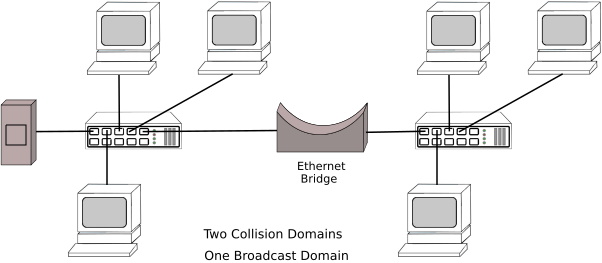
Figure 9-2 Ethernet Bridge
A bridge joins two or more LAN segments, typically two Ethernet LAN segments. Each LAN segment is in a separate domain, as shown in Figure 9-2. As a result, an Ethernet bridge can be used to scale Ethernet networks to a larger number of attached devices.
Unlike a hub, which blindly forwards received bits, a bridge (specifically, an Ethernet bridge in this discussion) makes intelligent forwarding decisions based on the destination MAC address in a frame. Specifically, a bridge analyzes source MAC address information on frames entering the bridge and populates an internal MAC address table based on the learned information. Then, when a frame enters the bridge destined for a MAC address known by the bridge's MAC address table to reside off a specific port, the bridge can intelligently forward the frame out the appropriate port. (This operation is logically the same as switch operation, and a more detailed description is presented in the upcoming discussion on switches.) Because a bridge makes forwarding decisions based on Layer 2 information (that is MAC addresses), a bridge is considered to be a Layer 2 device.
Although a bridge segments a LAN into multiple collision domains (that is, one collision domain per bridge port), all ports ona bridge belong to the same broadcast domain. To understand this concept, think about the destination MAC address in a broadcast frame. At Layer 2, the destination MAC address of a broadcast frame is FFFF.FFFF.FFFF in hexadecimal notation. Also, recall that a bridge has previously learned the destination MAC address in its MAC address table. Because no device on a network will have the MAC address FFFF.FFFF.FFFF, a bridge will never enter that MAC address in its MAC address table. As a result frames are Flooded out all bridge ports other than the port that received the frame.
Bridges were popular in the mid-to-late 1980s, but they have largely been replaced with switches due to price, performance, and features. From a performance perspective, a bridge makes its forwarding decisions in software, whereas a switch makes its forwarding decisions in hardware, using application-specific integrated circuits (ASICs). Not only do these ASICs help reduce the true cost of switches, they enable switches to offer a wider array of features. In fact, this book you are holding discusses a variety of these switch features, including VLANS, trunks, port mirroring, Power over Ethernet (PoE), Power over Ethernet Plus (PoE+), and 802.1X authorization.
• A MAC address is a unique 48-bit identifier number assigned to a piece of network hardware by its manufacturer. The MAC address is used at Layer 2, the data link layer, of the OSI reference model.
About The Author
Anthony Sequeira, CCIE No. 15626, is a Cisco Certified Systems Instructor (CCSI) and author regarding all levels and tracks of Cisco Certification. Anthony formally began his career in the information technology industry in 1994 with IBM in Tampa, Florida. He quickly formed his own computer consultancy, Computer Solutions, and then discovered his true passion-teaching and writing about Microsoft and Cisco technologies. Anthony joined Mastering Computers in 1996 and lectured to massive audiences around the world about the latest in computer technologies. Mastering Computers became the revolutionary online training company, KnowledgeNet, and Anthony trained there for many years. Anthony is currently pursuing his second CCIE in the area of Security and is a full-time instructor for the next-generation of KnowledgeNet, StormWind.com. Anthony is also a VMware Certified Professional.
CompTIA Network+ N10-008 Cert Guide contains proven study features that allow you to succeed on the exam the first time. Expert instructor Anthony Sequeira shares preparation hints and test-taking tips, helping you identify areas of weakness and improve both your conceptual knowledge and hands-on skills, essential for successful completion of the performance-based testing items on the exam. This complete, CompTIA-approved study package includes the following:
• A test-preparation routine proven to help you pass the exams
• Clearly defined chapter learning objectives covering all N10-008 exam topics
• Chapter-ending review questions and exam preparation exercises, which help you drill on key concepts you must know thoroughly
• The powerful Pearson Test Prep practice test software, complete with hundreds of well-reviewed, exam-realistic questions, customization options, and detailed performance reports
• 40 performance-based exercises to help you prepare for the hands-on exam questions
• A free copy of the CompTIA Network+ N10-008 Simulator Lite software, complete with meaningful lab exercises that enhance your hands-on skills
• More than 60 minutes of video mentoring
• A final preparation chapter that guides you through tools and resources to help you craft your review and test taking strategies
• An Exam Essentials appendix that quickly recaps all major chapter topics for easy reference, both in print and interactive digital format
• A key terms Glossary in both print and on the companion website, which acts as an interactive flash-card application
• Study plan suggestions and templates to help you organize and optimize your study time
• A 10% exam discount voucher (a $33+ value!)
Well regarded for its level of detail, study plans, assessment features, challenging review questions and exercises, video instruction, and hands-on labs, this approved study guide helps you master the concepts and techniques that ensure your exam success.
Master the topics on the CompTIA Network+ N10-008 exam, including:
• Network topologies and media types
• IP addressing
• Network services
• Data center architectures and cloud concepts
• Routing, Ethernet switching, and wireless networking
• Network availability and disaster recovery
• Network security
• Remote access
• Network troubleshooting
Learn more about the CompTIA Network+ N10-008 Cert Guide at amazon.com
More Networking Topologies Articles:
• Network Topologies
• Transparent Bridging and MAC Address Filtering
• Routers
• Trunking, Bonding, Aggregation; What Does it Mean?
• What is Fiber Optic Splicing?
• What Are Fiber Optic Circulators?
• VLAN (Virtual Local Area Network) Basics
• Network Storage Server Options
• Access Points and Wireless LAN Controller
• The Difference Between a Hub and a Router



